There is something particularly painful about encountering one's fellow countrymen abroad. It’s the discomfort of witnessing your peoples’ specific flavour of tourism; their particular habits and mannerisms a mirror for all the worst aspects of your own home culture. Or maybe that’s just a British thing? Canvassing opinion from Australians and Americans I’ve heard mixed responses.
Certainly I’ve witnessed Irish people spot each other from a mile off and actively seek out conversation, greeting each other like family. A lady from Cork followed me into a bathroom recently to chat, then apologised when she heard my accent (“Oh sorry I thought you must be Irish, you look it”). She seemed disappointed and I didn’t blame her. I hear a British accent – from any region, but especially a plummy, Home Counties one – and I cringe. Dave’s the same.
Maybe it’s something to do with how British people, when overheard, are so often speaking 20 per cent louder and 20 per cent slower than necessary, and they’re usually saying something obnoxious. A teacher from London loudly explaining sun protector factors to an Argentinian waitress in a bar. British people love to explain things. A drunk girl in the corner shop bellowing “Glory hunter!!” at the bewildered Panamanian shop assistant for wearing a Manchester City football shirt. A part of me dies inside. Do I say embarrassing things like that? Is that how people perceive me here? I don't think so. But it's a reminder to stay vigilant, act normal. Don't be cringe, don’t be a cliché for god's sakes.
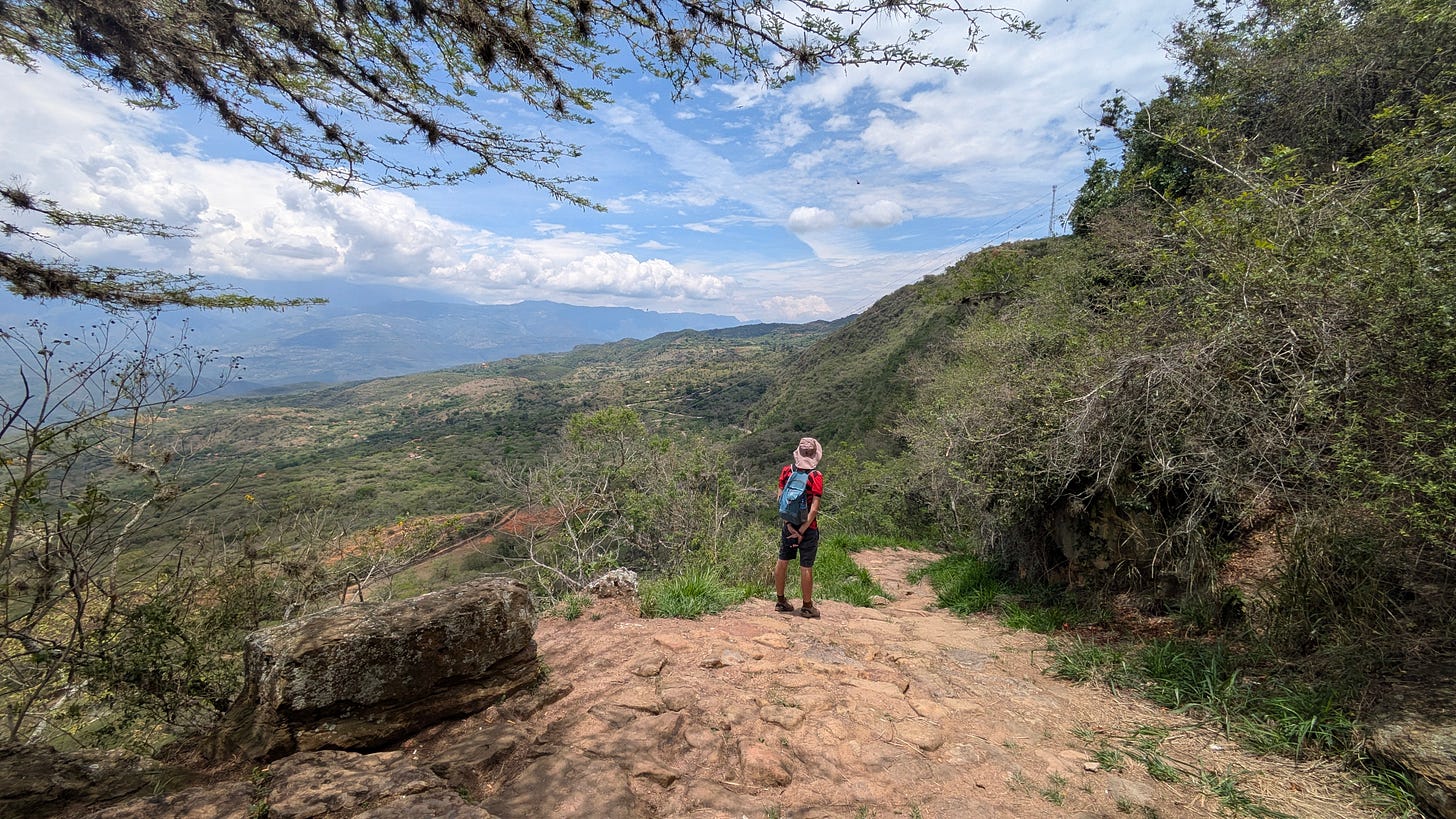
Colombia has been the first place on this trip where we've really started encountering British tourists in the wild – and specifically the same couples and groups from place to place. Sure, there have been one or two moments in the past few months when our our ears pricked up to hear our own accents, but it really was rare – I could count the number of British people we've spoken to on one hand. But then, in the north Colombian town of Barichara recently, I observed a Scottish couple in a cafe wearing “Bigfoot” volcano boarding t shirts – I recognised the name of the tour operator, because I did the same day trip with them back in 2013. We saw them again in Minca the following week and gave each other the gringo nod of acknowledgement. But that’s about as close as we were going to get to hanging out.
Bumping into the same people again and again was fairly common last time I went backpacking through Central America, and I'm sure it still is, because the region is so much smaller and everyone tends to be going either up or down through the same channels. And so this fellow Brit spotting, quite a new occurrence for us in South America, felt like a sign we were getting close to hitting the gringo trail. Not a bad thing, not an especially positive thing – just a sign that we were transitioning into the next phase of our trip.
Arriving in Bogotá off the overnight bus from Medellín, I felt like death. After months of mostly smooth (or at least manageable) rides across South America, I emerge from bus journeys in Colombia feeling like I’ve been shaken about in a metal can for eight hours (or twenty). The roads are bad, but the buses are also older and clunkier, with zero suspension. It makes it difficult to sleep on the bus, let alone read a book or write this newsletter, like I used to. I spend the hours staring ahead, feeling uncomfortable and nauseous instead.
So it was especially unfortunate to land back in the capital on zero sleep before anything much had opened, let alone our Airbnb, at 6.30am one Sunday morning. We spent a pleasant few hours in Britije bakery, where we watched them make the most incredible array of pastries in house, with the Sunday runners and cyclists meeting for their post-workout coffees all around us. But we were both beyond exhausted, and evidently we needed a new plan to stop us falling asleep in the café. Dave remembered the cute cinema we'd seen nearby during our previous visit to the capital. And so for one British Pound Sterling each, we sat and watched Flow (an animation film about a cat… but is it really about climate change!?!) with the intention of napping – but of course it was far too gripping and emotional for any chance of that. I think both of us had a little cry by the end, and not just at the thought of having to get up and walk around again, being awake.
Housed and recovered later that day, we enjoyed La Macarena, a new part of town for us. The restaurants and Vinoteca Libertad wine bar did well out of us. But the main reason for coming back to Bogotá was to visit the vast Zipaquirá underground salt cathedral – and most importantly, take the train from Bogotá city to get there (only our second of Latin America). The train is part of the “Savannah” railway line, built in the 19th century as a commercial route connecting Bogotá with the salt mines in Zipaquirá. Today it’s purely open for weekend tourism, a popular day trip for local families that comes complete with multiple travelling mariachi bands.
The Colombian tourism board describes Zipaquirá as the “First Wonder of Colombia…a symbol of ingenuity and spirituality of the Colombian people.” I would describe it as a 90s acid trip. A-level art fuelled by religious angst. Romeo + Juliet (1996): Leo DiCaprio doing his walk of death through the churchyard of neon crosses. There are a lot of neon-lit crosses, basically.
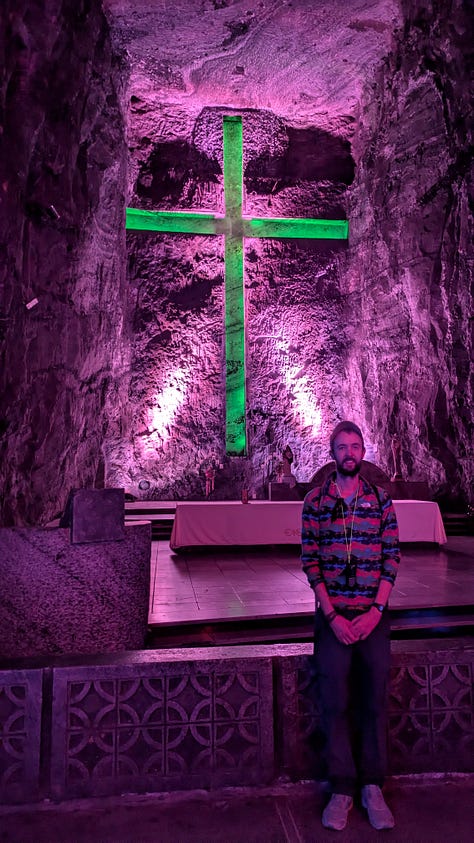
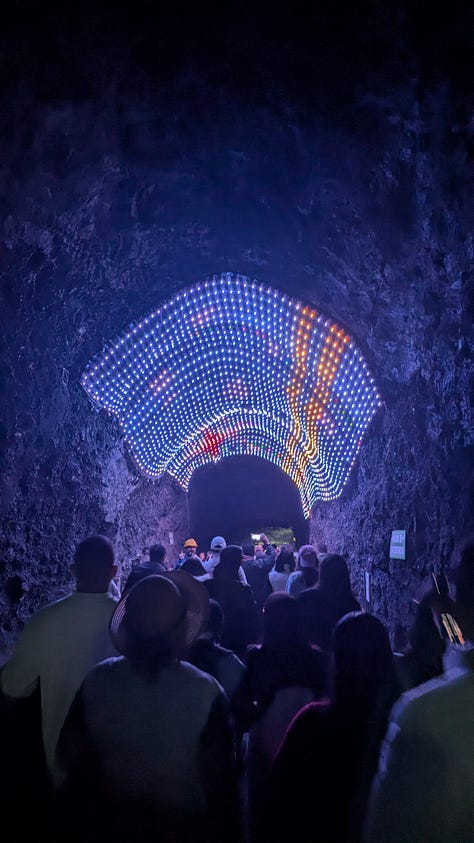

Zipaquirá began as a salt mine – and there is evidence of salt mining of sorts taking place at this site since the 5th century BC, which is mad in itself. The Spanish took it over in 1801, as was their tendency, and the miners started to carve out catholic chapels in the rocks for a convenient little pray before heading deeper into the gloom. An official underground cathedral was constructed in the 1950s, and eventually the working mine closed, converting the existing chambers into yet more cathedral passages that are now open as a strange and magnificent tourist attraction.
The cathedral as it stands today is 200 metres underground and 5,500 square metres in size – it’s absolutely vast. Dave and I joined the crowds of visiting Colombianos and their dogs, who are allowed in the cathedral, naturally (this is Colombia) but have to be wheeled around in little trolleys – which did not go down well with a couple of oversized German Shepherds and Great Danes, but the salt is apparently bad for their paws. I’d say most of the humans there were pretty into the whole God thing, but even as a recovering Catholic who is usually quite allergic to big displays of religious wealth, it was a cool space to explore. Think more Henry Moore or Rothko Chapel than St Mark’s Basilica in Venice.
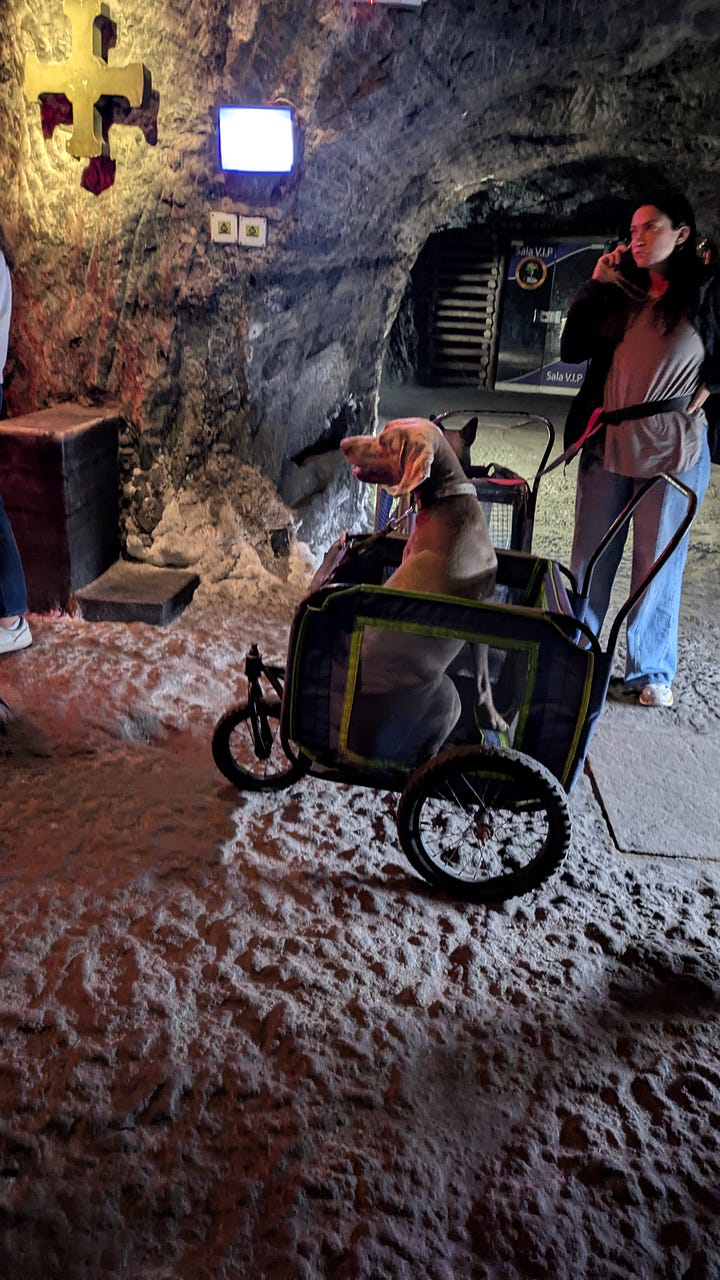

An audio guide read by a charming Irish voice guided us through the 14 chambers and informed us about which ones were inspired by women (allegedly) and which depicted Jesus’s suffering (most of them). Because the ceilings were so extraordinarily high, I didn’t feel claustrophobic about being underground. At the end of the tour, an incongruous and very industrial-chic bar was waiting for us – along with multiple gift shops specialising in bath salts, jewellery and some dinosaur toys for balance.
Once we’d had our fill of crucifixes, we had just enough time to enjoy lunch above ground overlooking Zipaquirá’s beautiful town square, before hopping on the tourist train back to Bogotá city with all the other boozed-up pilgrims. An absolutely cracking day out.
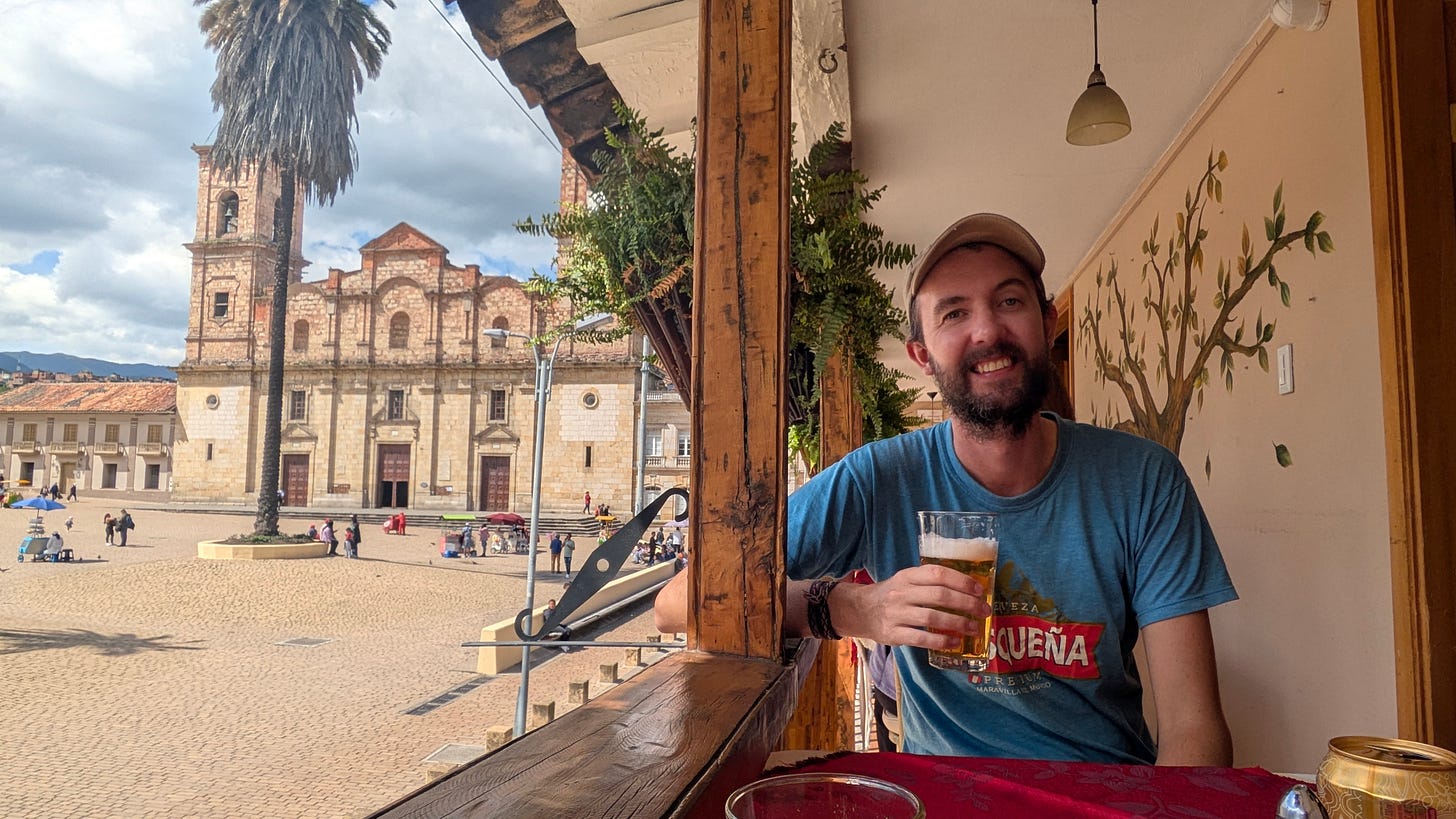
Here’s something bleak to depress you about the future of the planet: Bogotá has run out of water. The first time we visited the city (landing from Brazil in March) the Airbnb we stayed in was so fancy it had its own water reserves, and so we didn’t notice anything different. It was only while out to dinner one night that a waiter explained the situation to us – I’d thought it strange that places in the area were closing early, before 9pm, and this coupled with the strategically-placed buckets of water in an otherwise very upmarket restaurant bathroom made me wonder.
A big part of the problem is that Bogotá takes its water supply from the naturally-occurring Chingaza reservoir to the northeast of the city, but years of drought exacerbated by El Niño chaos caused it to finally run dry in 2024. To try and mitigate the problem, Bogotá was split into nine zones, and a rationing timetable was put in place. During our stay, each zone had its water completely shut off for a 24-hour period every nine days (although in reality it more like 36 hours). Some wealthier homes and apartment blocks have their own storage tanks installed for back-up supplies, so we were still able to take a shower, albeit with a low water pressure. In other areas, people had to time their showers strategically – and/or fill a bucket, as our waiter put it – and some schools and businesses just had to close. So a very unequal system.
I’ve experienced similar rationing systems in Cape Town (for water and, separately, electricity) but those issues are generally chalked up to political problems and poor governance, which people are very used to by now. There was something particularly shocking about the Bogotá drought. Everyone talks about a “day zero” in Mexico City (ie, that one projected day in the near future when the well runs finally dry) but the reality is there are several places in South America where “day zero” has already arrived. A famous example is the Cogoti reservoir in northern Chile, which used to serve the Coquimbo region its drinking water but completely dried up a few years ago. In most cases, governments have been able to find emergency solutions – build a new dam, funnel water in from elsewhere – and Bogotá’s drought officially ended in April, after Dave and I left and the rain came. But it’s clearly a problem for the future and “day zeros” are already becoming much more frequent in Andean regions.

From Bogotá it was finally time to head north towards the Caribbean coast, making a couple of stops along the way in Colombia’s Boyacá valley. We spent a few days in both Villa de Leyva and Barichara, two classically beautiful Spanish colonial towns in the Andean foothills. I could happily have spent a month or two in each.
At this point in my life, I reckon I've seen a sufficient number of quaint and pretty old towns with cobbled streets and white stone walls… there are plenty on this continent, as you might imagine. But I don’t think any of them can compare to Barichara. We visited Villa de Leyva first, already a perfect little place with its cute cafés, handsome old buildings and frankly enormous, historic central plaza. But for me, Barichara just topped it. What a ridiculously postcard-pretty place; not a single dud house or street.

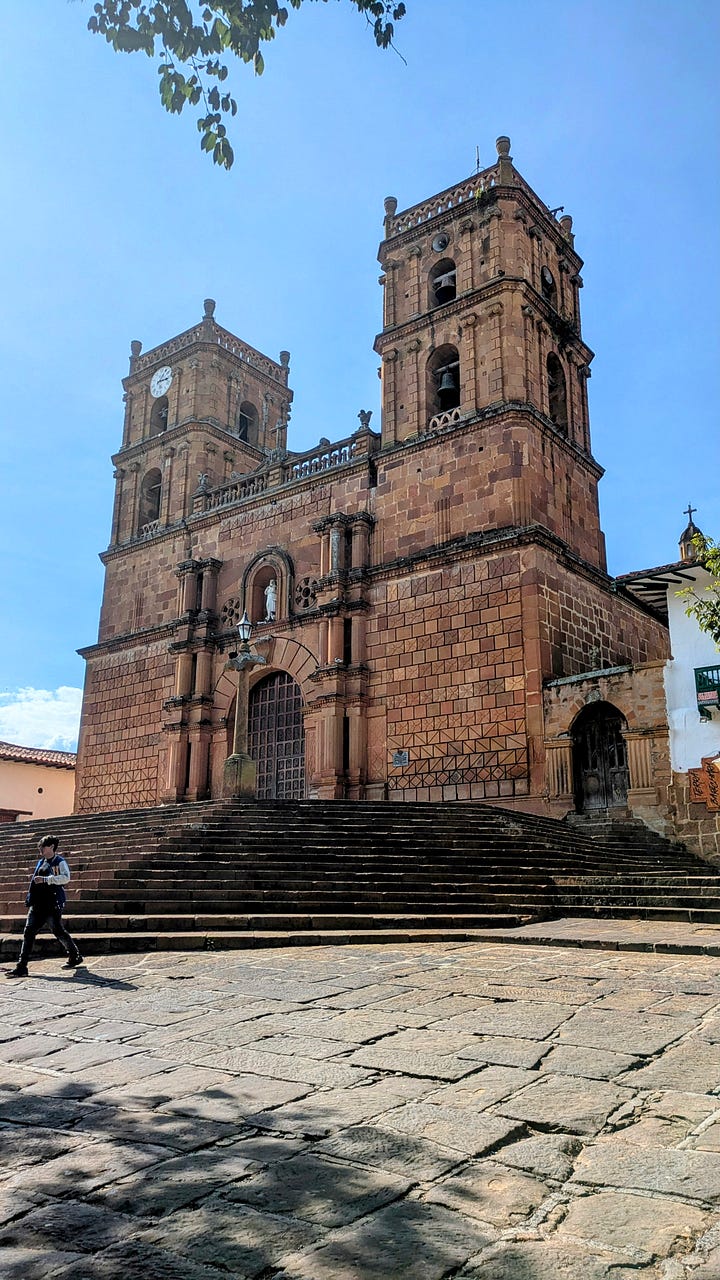
I have a vision of myself returning to Barichara and spending three months just sitting in one of its scenic garden cafés, writing some whimsical novel. I’m not quite sure how I’m funding this in this daydream, but here’s another thing – it was hella cheap to stay there, considering the chocolate-box scenery and historic sites. All very Instagramable. I suspect its affordability is helped by the fact both towns are popular with Colombian tourists (rather than predominantly gringos) but they also serve as living, working towns, too – neither one felt remotely spoilt or artificial.
I loved our time in both places. They reminded me a little bit of the towns in the Quebrada de Humahuaca, through northern Argentina – also up there in my top places to exist, pose, and generally hang out in. Villa de Leyva is perhaps best known for its prehistoric showcase. Around 145 million years ago, a big chunk of Colombia, including this valley, was below sea level, and lots of very big and funky prehistoric marine reptile fossils have been uncovered in and around Villa de Leyva in particular.
The town’s most famous resident is its monquirasaurus, or kronosaurus boyacensis, an almost complete fossilised skeleton about 7 metres long that was uncovered by some local farmers in the 1970s. There’s a very fun little museum housing him and the many other types of fossil found in the valley over the years. Dave also went for a run one morning out to El Infiernito (“little hell”), another archaeological site absolutely full of very tall, ancient phallic statues. Something to do with fertility, naturally, but all very odd and I would like to meet the woman who first named it that.

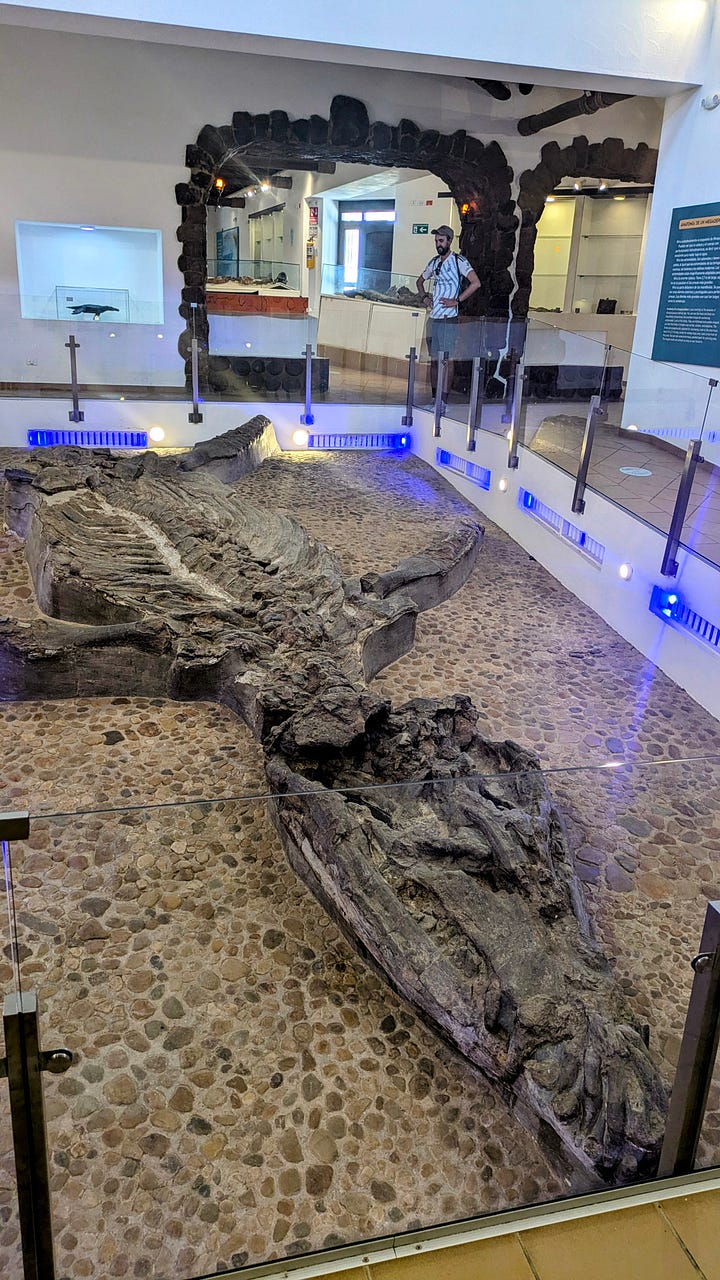
In Barichara, much of our time was spent sheltering from the heat in bars and cafés – all very pleasant – and we took a walk out through the valley to neighbouring Guane. We also ate some ants.
For the past couple of years, Barichara has held an exceedingly popular festival celebrating the tradition of harvesting and consuming hormigas culonas: big-bottomed ants. While the festival itself is relatively new, ants have been a local delicacy for more than 500 years, a tradition started by the Guane indigenous people, who lived in the valley before the Spanish came. They were ahead of their time: insects are periodically a big deal in European food scenes in the 21st century. It wasn't harvesting time when we stayed (I’m not sure if that's fortunate or unfortunate) but we sampled some of them in a nutty ant sauce over some very tasting sharing plates at Elvia Barichara.
And then to Santa Marta, our first stop along the Caribbean – the real Caribbean this time, and not just the seaside rubbish dump we visited in Georgetown, Guyana. It had been a while since we’d seen the sea – and while Santa Marta is a bit of an industrial town (not your classic beach for lazing on), the warm water and sunset views did not disappoint. I liked Santa Marta. It’s a bit of a party town, meaning endless happy hour deals and ham-faced English speakers – every air-conditioned café littered with tech guys on laptops, shouting at the phone in American – but it has some pleasant plazas and a good dining scene.
We mostly used the city as a stepping off point for exploring more of the Colombian coastline, starting with a day trip out to Taganga down the road, where locals bartered on the beach for fish and a resident eccentric sat down next to us to chat about Gabriel Garcia Marquez, another local. Like any self-respecting vagabond he half-heartedly asked us if we could spare some change, presumably in exchange for his lessons on Colombian literature, and Dave obliged, which would normally be the end of such an interaction but none of us could be bothered to move on. The three of us sat in a companionable silence watching the sunset together, occasionally pointing out new colours as they appeared in full spectrum across the sea and mountains beside us, which I think is all our literary friend wanted in the first place.
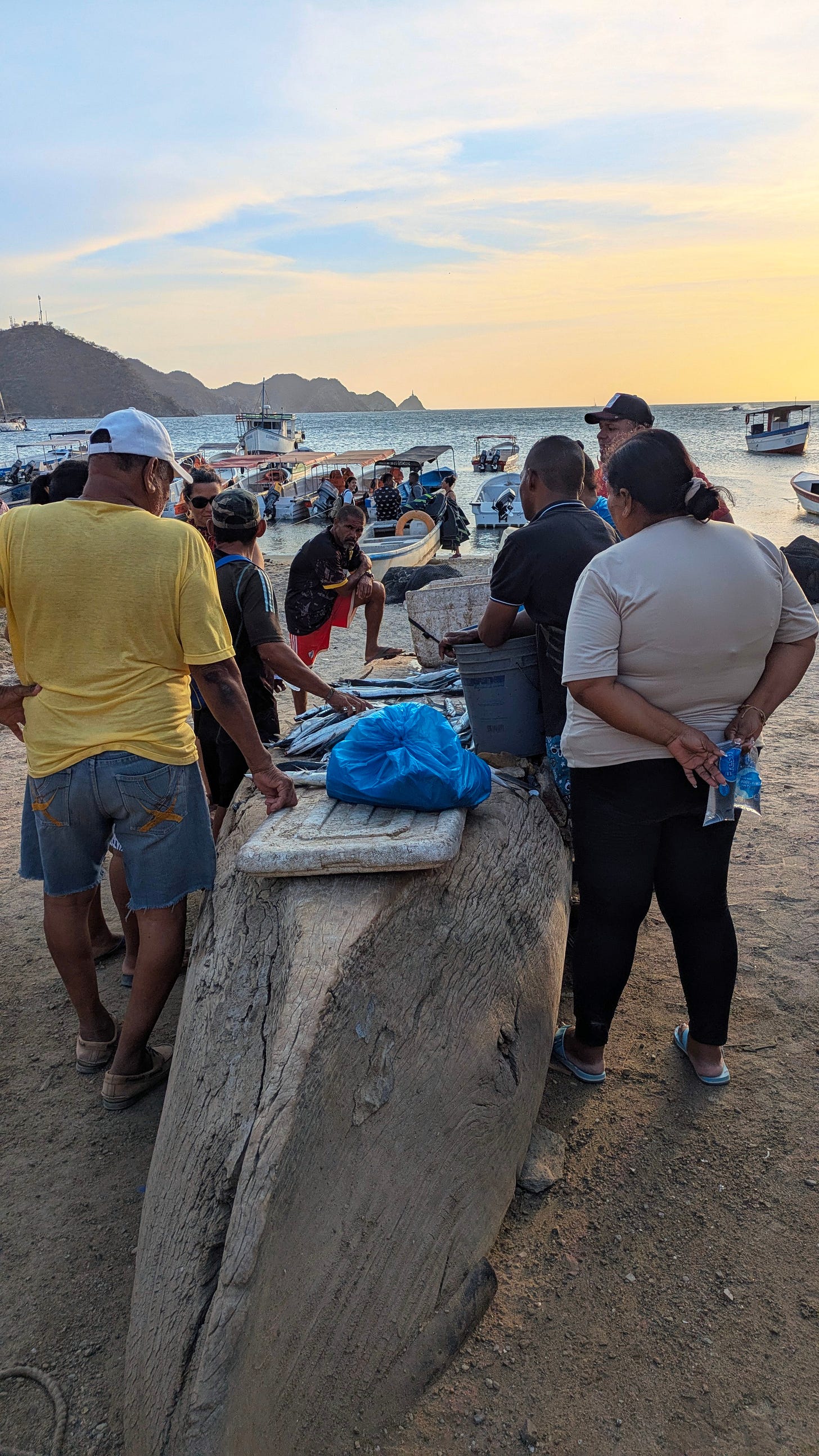
Travel bits and tips from this week
On our return visit to Bogotá we stayed in La Macarena neighbourhood in this tiny but great value Airbnb right in the heart of things. A lot of wining and dining took place, but the highlights were Vinoteca Libertad (great wine bar), Sándwich Taller (big falafel / sausagey burgers in fresh bread), Bruschetta (low-brow pasta) and La Monferrina (high-brow pasta).
We took the “turist tren” to Zipaquira and visited the salt cathedral without a booking. The train waits for four hours and then takes everyone back again, all very easy and comfortable organised fun. We had lunch overlooking the square at Restaurante Casa Nova.
Another day we took the cable car up to the Monserrate cathedral and monastery for some great views of the city.
In Villa de Leyva we went dinosaur spotting at the Museo El Fósil and then the Museo Paleontologico where we had one of our funniest museum interactions yet: the awkward and introverted woman on the door told us we weren’t allowed to go around without a tour guide but we resisted this because we were short on time, using our poor Spanish as an excuse. She said it was ok, her English-speaking colleague was on their way. Two minutes later, the same woman returned speaking perfect English and – completely devoid of humour – introduced herself as our tour guide. Still baffled.
We enjoyed food and drink at Cervecería HISCA, Chuska Cocina, Café Los Gallos, Tortello Pasta, Restaurante Bar Carnes Y Olivas, La Osteria and Los Vinos wine bar. We stayed in the lovely and very cheap Hotel Villa Palmas.
We may have missed out on Barichara’s big-bottomed ant festival, but we did happen to arrive in time for the region’s burger festival. Dave made it his mission to try all three winning restaurants in Barichara over one weekend: El Bodegón de Toñita Restaurante Bar (on the main square), Filomena (more burgers on a cute patio) and Voro Cocina.
We also ate at Elvia Barichara (ant sauce), Comidas Bari (pasta), Épice (arabic), restaurant, Milana (bit of everything), and we stayed at Hotel El Cogollo, another absolute cracking value hostel/guesthouse with excellent cats.
From Barichara it was three connections by bus up to Santa Marta, where we stayed in this Airbnb. We ate at Ikaro Cafe, Ouzo Santa Marta, El Mexican Santa Marta and Munchies Brunch.




